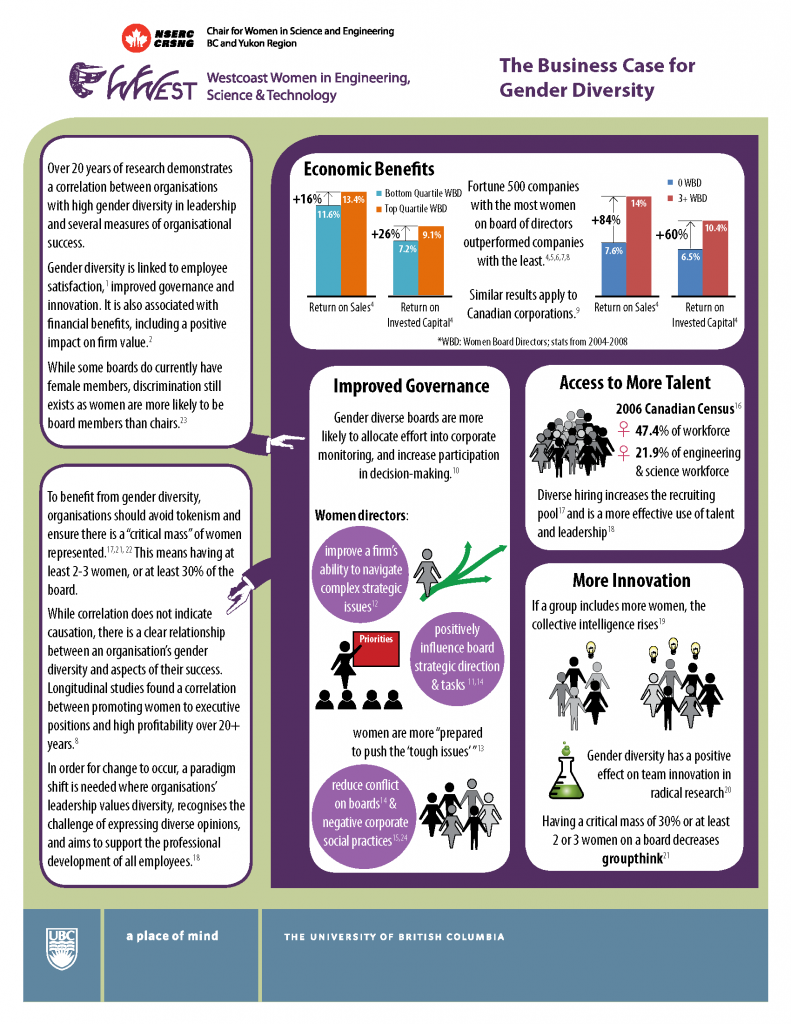Over 20 years of research demonstrates a correlation between organisations with high gender diversity in leadership and several measures of organisational success.
Gender diversity is linked to employee satisfaction,1 improved governance and innovation. It is also associated with financial benefits, including a positive impact on firm value.2
While some boards do currently have female members, discrimination still exists as women are more likely to be board members than chairs.23
To benefit from gender diversity, organisations should avoid tokenism and ensure there is a “critical mass” of women represented.17,21, 22 This means having at least 2-3 women, or at least 30% of the board.
While correlation does not indicate causation, there is a clear relationship between an organisation’s gender diversity and aspects of their success. Longitudinal studies found a correlation between promoting women to executive positions and high profitability over 20+ years.8
In order for change to occur, a paradigm shift is needed where organisations’ leadership values diversity, recognises the challenge of expressing diverse opinions, and aims to support the professional development of all employees.18
References
1. Orser, B. (2000). Creating high – performance organizations: Leveraging women’s leadership. The Conference Board of Canada. 31 pp. http://www.conferenceboard.ca/
2. Campbell, K. & Mínguez-Vera, A. (2008). Gender diversity in the boardroom and firm financial performance. Journal of Business Ethics, 83(3), 435-451.
3. Grosvold, J. (2011). Where are all the women? Institutional context and the prevalence of women on the corporate board of directors. Business & Society, 50(3), 531– 555.
4. Catalyst (2011). The bottom line: Corporate performance and women’s representation on boards (2004–2008). Retrieved from: http://www.catalyst.org/knowledge/bottom-line-corporate-performance-and-womens-representation-boards-20042008/
5. Catalyst (2004). The bottom line: Connecting corporate performance and gender diversity. Retrieved from: http://www.catalyst.org/knowledge/bottom-line-connecting-corporate-performance-and-gender-diversity/
6. Catalyst (2007). The bottom line: Corporate performance and women’s representation on boards. Retrieved from: http://www.catalyst.org/knowledge/bottom-line-corporate-performance-and-womens-representation-boards/
7. Adler, R. D. (1999). Women in the executive suite correlate to high profits. For European Project on Equal Pay. Retrived from: http://www.w2t.se/se/filer/adler_web.pdf.
8. Adler, R. (2009). Profit, thy name is … woman? Pacific Standard: The Science of Society. Retrieved from http://www.psmag.com/navigation/business-economics/profit-thy-name-is-woman-3920/
9. Brown, D. A. A., Brown, D.L. & Anastasopoulos, V. (2002). Women on boards: Not just the right thing … But the “bright” thing. The Conference Board of Canada. Retrieved from: http://www.conferenceboard.ca/
10.Adams, R., & Ferreira, D. (2009). Women in the boardroom and their impact on governance and performance. Journal of Financial Economics, 94(2), 291–309.
11. Lückerath-Rovers, M. (2013). Women on boards and firm performance. Journal of Management & Governance, 17(2), 491-509.
12. Francoeur, C., Labelle, R., & Sinclair-Desgagné, B. (2008). Gender diversity in corporate governance and top management. Journal of Business Ethics, 81(1), 83-95.
13. Estlad, B., & Ladegard, G. (2012). Women on corporate boards: Key influences or tokens? Journal of Management & Governance, 16(4), 595-615.
14.Nielsen, S., & Huse, M. (2010). The contribution of women on boards of directors: Going beyond the surface. Corporate Governance: An International Review, 18(2), 136-148.
15. Boulouta, I. (2013). Hidden connections: The link between board gender diversity and corporate social performance. Journal of Business Ethics, 113(2), 185-197.
16. Statistics Canada. (2006). Occupation – National Occupational Classification for Statistics 2006 (720), Class of Worker (6) and Sex (3) for the Labour Force 15 Years and Over of Canada, Provinces, Territories, Census Metropolitan Areas and Census Agglomerations, 2006 Census – 20% Sample Data. (Catalogue number 97-559-XCB2006011). Retrieved from: http://www12.statcan.gc.ca/
17. Mathisen, G. E., Ogaard, T., & Marnburg, E. (2013). Women in the boardroom: How do female directors of corporate boards perceive boardroom dynamics? Journal of Business Ethics, 116(1), 87–97.
18.Mannix, E., & Neale. M.A. (2005). What differences make a difference? The promise and reality of diverse teams in organizations. Psychological Science in the Public Interest, 6(2), 31-55.
19. Woolley, A., Malone, T. & Berinato, (2011). What makes a team smarter? More women. Harvard Business Review, 89 (6), 32-33. Retrieved from: http://hbr.org/2011/06/defend-your-research-what-makes-a-team-smarter-more-women/ar/1
20. Diaz-Garcia, C., Gonzalez-Moreno, A., & Saez-Martinez, F.J. (2013). Gender diversity within R&D teams: Its impact on radicalness of innovation. Innovation: Management, Policy, & Practice, 15(2), 149- 160.
21. Torchia, M., Calabrò, A., & Huse, M. (2011). Women directors on corporate boards: From tokenism to critical mass. Journal of Business Ethics, 102(2), 299–317.
22. Joecks, J., Kerstin, P., & Vetter, K. (2013). Gender diversity in the boardroom and firm performance: What exactly constitutes a “critical mass?” Journal of Business Ethics, 118(1), 61-72.
23. Simpson, G., Carter, D.A., & D’Souza, F. (2010). What do we know about women on boards? Journal of Applied Finance, 20(2), 27-39.
24. Galbreath, J. (2011). Are there gender-related influences on corporate sustainability? A study of women on boards of directors. Journal of Management and Organization ,17(1),17-38.
